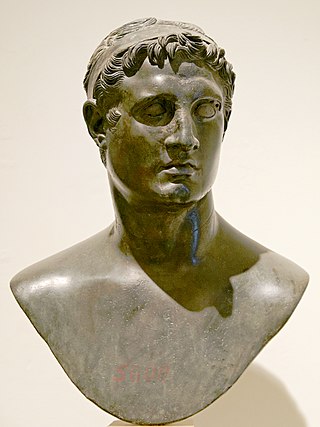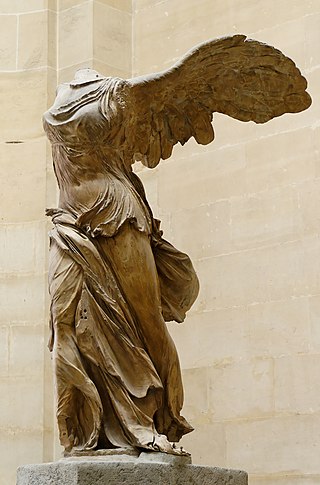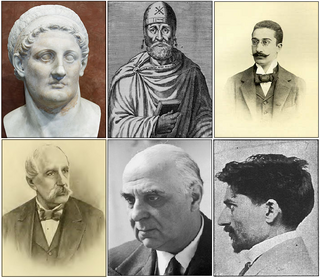
The Great Library of Alexandria in Alexandria, Egypt, was one of the largest and most significant libraries of the ancient world. The library was part of a larger research institution called the Mouseion, which was dedicated to the Muses, the nine goddesses of the arts. The idea of a universal library in Alexandria may have been proposed by Demetrius of Phalerum, an exiled Athenian statesman living in Alexandria, to Ptolemy I Soter, who may have established plans for the Library, but the Library itself was probably not built until the reign of his son Ptolemy II Philadelphus. The Library quickly acquired many papyrus scrolls, owing largely to the Ptolemaic kings' aggressive and well-funded policies for procuring texts. It is unknown precisely how many scrolls were housed at any given time, but estimates range from 40,000 to 400,000 at its height.

The Ptolemaic dynasty, also known as the Lagid dynasty, was a Macedonian Greek royal house which ruled the Ptolemaic Kingdom in Ancient Egypt during the Hellenistic period. Reigning for 275 years, the Ptolemaic was the longest and last dynasty of ancient Egypt from 305 BC until its incorporation into the Roman Republic in 30 BC.

The 2nd century BC started the first day of 200 BC and ended the last day of 101 BC. It is considered part of the Classical era, although depending on the region being studied, other terms may be more suitable. It is also considered to be the end of the Axial Age. In the context of the Eastern Mediterranean, it is the mid-point of the Hellenistic period.

Cleopatra VII Thea Philopator was Queen of the Ptolemaic Kingdom of Egypt from 51 to 30 BC, and its last active ruler. A member of the Ptolemaic dynasty, she was a descendant of its founder Ptolemy I Soter, a Macedonian Greek general and companion of Alexander the Great. Her first language was Koine Greek, and she is the only Ptolemaic ruler known to have learned the Egyptian language. After her death, Egypt became a province of the Roman Empire, marking the end of the last Hellenistic-period state in the Mediterranean, a period which had lasted since the reign of Alexander.

Ptolemy II Philadelphus was the pharaoh of Ptolemaic Egypt from 284 to 246 BC. He was the son of Ptolemy I, the Macedonian Greek general of Alexander the Great who founded the Ptolemaic Kingdom after the death of Alexander, and Queen Berenice I, originally from Macedon.

Ptolemy IV Philopator was the fourth pharaoh of Ptolemaic Egypt from 221 to 204 BC.

Ptolemy XII Neos Dionysus was a king of the Ptolemaic Kingdom of Egypt who ruled from 80 to 58 BC and then again from 55 BC until his death in 51 BC. He was commonly known as Auletes, referring to his love of playing the flute in Dionysian festivals. A member of the Ptolemaic dynasty, he was a descendant of its founder Ptolemy I, a Macedonian Greek general and companion of Alexander the Great.
Lycophron was a Hellenistic Greek tragic poet, grammarian, and commentator on comedy, to whom the poem Alexandra is attributed.

Cleopatra V was a Ptolemaic Queen of Egypt. She is the only surely attested wife of Ptolemy XII. Her only known child is Berenice IV, but she was also probably the mother of Cleopatra VII. It is unclear if she died around the time of Cleopatra VII's birth in 69 BC, or if it was her or a daughter named Cleopatra VI who co-ruled Ptolemaic Egypt with Berenice IV in 58–57 BC during the political exile of Ptolemy XII to Rome. No written records about Cleopatra V exist after 57 BC and two years later Berenice IV was overthrown by Ptolemy XII, his throne restored with Roman military aid.
The Letter of Aristeas to Philocrates is a Hellenistic work of the 3rd or early 2nd century BC, considered by some Biblical scholars to be pseudepigraphical. The letter is the earliest text to mention the Library of Alexandria.

In classical antiquity, the Hellenistic period covers the time in Greek history after Classical Greece, between the death of Alexander the Great in 323 BC and the death of Cleopatra VII in 30 BC, which was followed by the ascendancy of the Roman Empire, as signified by the Battle of Actium in 31 BC and the Roman conquest of Ptolemaic Egypt the following year, which eliminated the last major Hellenistic kingdom. Its name stems from the Ancient Greek word Hellas, which was gradually recognized as the name for Greece, from which the early modern 19th century historiographical term Hellenistic was derived. The term "Hellenistic" is to be distinguished from "Hellenic" in that the latter refers to Greece itself, while the former encompasses all the ancient territories of the period that had come under significant Greek influence, particularly the Hellenized Middle East, after the conquests of Alexander the Great.

Hellenistic Greece is the historical period of Ancient Greece following Classical Greece and between the death of Alexander the Great in 323 BC and the annexation of the classical Greek Achaean League heartlands by the Roman Republic. This culminated at the Battle of Corinth in 146 BC, a crushing Roman victory in the Peloponnese that led to the destruction of Corinth and ushered in the period of Roman Greece. Hellenistic Greece's definitive end was with the Battle of Actium in 31 BC, when the future emperor Augustus defeated Greek Ptolemaic queen Cleopatra VII and Mark Antony, the next year taking over Alexandria, the last great center of Hellenistic Greece.
The Alexandrian school is a collective designation for certain tendencies in literature, philosophy, medicine, and the sciences that developed in the Hellenistic cultural center of Alexandria, Egypt during the Hellenistic and Roman periods.

The Ptolemaic Kingdom or Ptolemaic Empire was an Ancient Greek polity based in Egypt during the Hellenistic period. It was founded in 305 BC by the Macedonian general Ptolemy I Soter, a companion of Alexander the Great, and ruled by the Ptolemaic dynasty until the death of Cleopatra VII in 30 BC. Reigning for nearly three centuries, the Ptolemies were the longest and final dynasty of ancient Egypt, heralding a distinctly new era for religious and cultural syncretism between Greek and Egyptian culture.

The Egyptian Greeks, also known as Egyptiotes or simply Greeks in Egypt, are the ethnic Greek community from Egypt that has existed from the Hellenistic period until the aftermath of the Egyptian coup d'état of 1952, when most were forced to leave.

The history of Alexandria dates back to the city's founding, by Alexander the Great, in 331 BC. Yet, before that, there were some big port cities just east of Alexandria, at the western edge of what is now Abu Qir Bay. The Canopic (westernmost) branch of the Nile Delta still existed at that time, and was widely used for shipping.
Archagathus was a Syracusan from Magna Graecia prince and Ptolemaic official who lived around the late second half of the 4th century BC and first half of the 3rd century BC.
Stratonice was a Greek noblewoman of very high status and was the wife of the Ptolemaic official Archagathus of Libya.

Coinage of the Ptolemaic kingdom was struck in Phoenician weight, also known as Ptolemaic weight which was the weight of a Ptolemaic tetradrachm. This standard, which was not used elsewhere in the Hellenistic world, was smaller than the dominant Attic weight which was the weight of standard Hellenistic tetradrachm. Consequentially, Ptolemaic coins are smaller than other Hellenistic coinage. In terms of art, the coins, which were made of silver, followed the example set by contemporary Greek currencies, with dynastic figures being typically portrayed. The Ptolemaic coin making process often resulted in a central depression, similar to what can be found on Seleucid coinage.

The early life of Cleopatra VII covers the period from Cleopatra's birth in early 69 BC to her accession to the throne during or before March 51 BC. Cleopatra was born to the reigning pharaoh of Ptolemaic Egypt, Ptolemy XII Auletes; the identity of her mother is disputed and is presumed to have been Cleopatra V or Cleopatra VI, who may have been the same person. During her early childhood, Cleopatra was brought up in the palace of Alexandria in Egypt and received a primarily Hellenistic Greek education. By adulthood she was well-versed in many languages, including Egyptian, Ethiopian, Hebrew, Arabic, Median, Parthian, Latin, and her native Koine Greek.

















